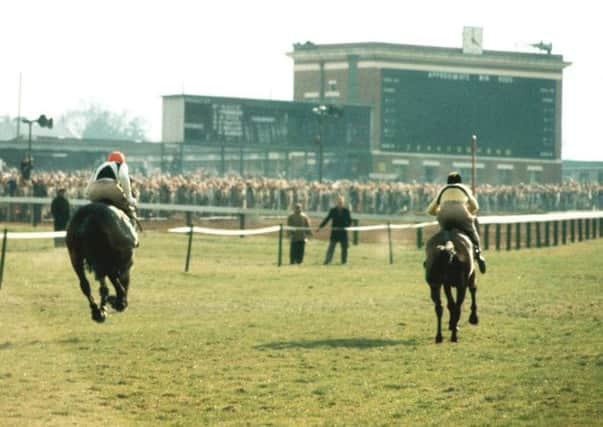How Arkle usurped Mill House as the darling of racing with Gold Cup win


No appreciation of Arkle would be complete without a reminder of Sir Peter O’Sullevan’s velvet voice as the greatest steeplechaser in history won his first Cheltenham Gold Cup 50 years ago.
Even though this was just the first of three successive Gold Cups to be won by the Irish champion in the iconic yellow and black colours of his owner Anne, Duchess of Westminster, O’Sullevan’s unrivalled words reflected the significance of Arkle’s victory over the previously invincible Mill House.
Advertisement
Hide AdAdvertisement
Hide AdThe Fulke Walwyn-trained horse had been regarded as the best steeplechaser since Golden Miller was winning the last of his five Gold Cups in 1936, but was made to look distinctly ordinary by the pride of Ireland who rewrote jump racing’s record books before injury curtailed his career in the 1966 King George.
In short, Mill House was never the same horse after Arkle swept alongside the long-time leader at the second-last fence at the end of a duel that had been as widely anticipated as a Muhammad Ali fight.
Yet, four months earlier, it was Mill House who was in the ascendancy when winning Newbury’s Hennessy Cognac Gold Cup – with his young pretender from across the Irish Sea back in third after a rare jumping error.
One person not surprised by the dethronement of Mill House was the former champion jockey Stan Mellor whose King’s Nephew finished a remote last of the four runners in the 1964 Gold Cup.
Advertisement
Hide AdAdvertisement
Hide AdBorn in 1937, he holds the rare distinction of having beaten both of the great champions – the Frank Cundell-trained King’s Nephew beat Mill House in his novice season at Kempton.
Mellor was aboard the unfancied Stalbridge Colonist who took advantage of a light weight to lower the colours of Arkle in the 1966 Hennessy.
“I haven’t seen a better horse before or since Arkle,” Mellor, the first jump jockey to ride 1,000 career winners, told The Yorkshire Post. “It was just a great honour to be part of the 1964 Gold Cup which was rightly described, in my view, as the race of the century. Though many were surprised that Mill House was beaten, I wasn’t in that camp – I thought he was vulnerable after winning the Kempton race on King’s Nephew.
“I jumped the second-last four or five lengths behind him and was able to come up the inner and fly the last. He didn’t know I was there. You have to make speed count.”
Advertisement
Hide AdAdvertisement
Hide AdAs for the Gold Cup, Mellor was a spectator on King’s Nephew – even though his mount had won the Great Yorkshire Chase at Doncaster. He recalls how alternating snow and sun added to the atmosphere as the gladiators (Pas Seul made up the quartet) went to the start.
As Sean Magee’s acclaimed 50th anniversary edition of Arkle: The Story of the World’s Greatest Steeplechaser reveals, this race looked to be anticlimactic as Mill House, and his rider Willie Robinson, established a wide-margin lead.
The lack of urgency on the part of Arkle’s jockey Pat Taaffe reverberated throughout the crowd and reached O’Sullevan’s commentary box who observed: “Irish voices in the stands are calling for Pat now!”
The timing was perfect; Magee’s beautifully produced book notes how horse and rider responded as “if they had heard the encouragement from a mile away”.
Advertisement
Hide AdAdvertisement
Hide AdHowever, a fine leap by Mill House at the downhill third-last fence maintained the superiority of the home favourite until his lead disappeared in a flash at the penultimate obstacle. Onto the last and Arkle was ahead by a length for the first time. As Mill House tried to battle back, Arkle found another gear and sprinted up the punishing final hill in a winning time of six minutes 45.6 seconds which broke the course record by four seconds.
Mill House was shattered and so was his jockey – the amateur rider Brough Scott observed Robinson back in the sanctuary of the weighing room “sitting on the bench just as shattered as if he had been taken out by the young Cassius Clay”.
Yet Mellor was among the first to appreciate Taaffe’s judgment of pace.
“With Arkle in 1964, he was able to ease alongside Mill House at the end of a three-mile gallop that had been relentless,” he said.
Advertisement
Hide AdAdvertisement
Hide Ad“It’s what I did on Stalbridge Colonist in the 1966 Hennessy. The grey was getting 37lb and I thought we had a chance. Arkle jumped the second-last going very well and clear, and I was four or five lengths down.
“But I was directly behind him. People say the weight beat Arkle, but it was because Pat hadn’t seen my horse.
“The way we went past Arkle, and then the great horse battled back, the champion actually went up in my estimation – even in defeat.
“The great thing is to conserve speed. If you can do that, you’ve got the element of surprise. It’s why the 1964 Gold Cup is the greatest... no one knew just how much Arkle had in hand.”
Sir Peter O’Sullevan was right. Arkle’s like has not been seen again.
Arkle: The Story of the World’s Greatest Steeplechaser by Sean Magee is published by Racing Post Books, price £16.99.